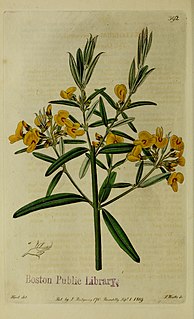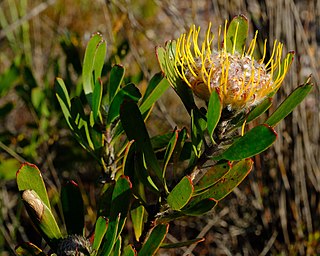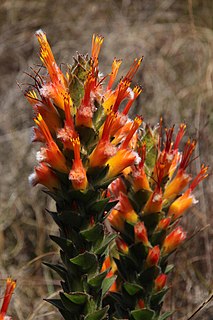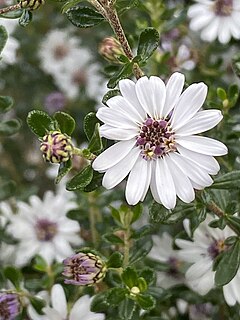
Mimetes arboreus, or Kogelberg pagoda, is an evergreen, upright large shrub or small tree of 2–6 m (6½–20 ft) high in the family Proteaceae. It grows from a thick trunk with a smooth grey bark that branches at ½–1 m (1½–3 ft) above the ground. It has silvery, lance-shaped, pointy leaves of 5–8¼ cm (2.0–3.3 in) long and ¾–3¼ cm (0.3–1.3 in) wide, at an upward angle and overlapping each other. The inflorescences are set just below the top of the branches, are cylinder-shaped, 8–10 cm in diameter, topped by a crest of more or less horizontal pinkish or reddish tinged leaves. It consists of several flower heads in the axils of pinkish orange leaves that form a hood shielding the underlying flower head. Each flower head contains eight to thirteen individual flowers, with bright red styles and grey silky perianth lobes. It is endemic to the Fynbos ecoregion of South Africa, being confined to the Kogelberg mountain range.

Mimetes hirtus is an upright, evergreen shrub of 1½–2 m high from the family Proteaceae. It has upright, overlapping, (broadly) lance-shaped leaves, without teeth, but with one thickened pointy tip. It has cylindric inflorescences topped by a pine apple-like tuft of pinkish-brownish, smaller and more or less horizontal leaves. The flowerheads are tightly enclosed by yellow, red-tipped bracts, only the 9–14 long red styles and the whitish silky tips of the perianth sticking out. It is primarily pollinated by the Cape sugarbird. It is an endemic species of the southwest of the Western Cape province of South Africa, and grows in wet zones at the base of south facing mountain slopes. Flower heads may be found from May to November, but peaks in July and August. The species has several vernacular names of which marsh pagoda seems to be used most.

Hakea trifurcata, commonly known as two-leaf, two-leaved hakea, or kerosene bush, is a shrub, endemic to the south-west of Western Australia. The species has two leaf forms, needle-like or oblong egg-shaped. Unlike most hakea species the fruit remain green at maturity and resemble the broader leaf form. The mimicry creates a camouflage, reducing predation of the seed by granivores in particular cockatoos.

Hakea tephrosperma commonly known as hooked needlewood, is a shrub or small tree species in the family Proteaceae. One of the taller species and adaptable for dry to temperate locations.

Hakea laevipes is a shrub in the family Proteaceae. A widespread species found growing on coastal and tableland locations mainly in eastern New South Wales, with scattered populations in south-eastern Queensland.

Oxylobium arborescens, commonly known as the tall shaggy-pea, is a species of flowering shrub to small tree in the family Fabaceae and is endemic to south-eastern Australia. It has elliptic dark green leaves and yellow pea flowers.

Hakea pandanicarpa is a shrub species in the family Proteaceae. It is endemic to south-west Western Australia.

Hakea trineura is a shrub of the family Proteaceae and is endemic to Queensland Australia. It has large pendulous greenish-yellow flowers from May to September.

Hakea kippistiana is a shrub in the family Proteacea and endemic to Western Australia. It is a dense prickly shrub with sharp needle-shaped leaves with fragrant white, cream or pink flowers from November to February.
Hakea tuberculata is a shrub in the family Proteaceae, endemic to several isolated areas along the coast in the Peel, South West, Great Southern and Goldfields-Esperance regions of Western Australia.

Hakea smilacifolia is a shrub in the family Proteacea. It has sweetly scented flowers, stiff leathery leaves and is endemic to an area in the Mid West, western Wheatbelt and the Goldfields-Esperance regions of Western Australia.

Leucospermum praemorsum is an evergreen shrub or small tree of up to 5 m (16 ft) high. It has hairless oblong to inverted lance-shaped leaves of 7–8 cm long and 1½–2 cm wide, tapering at their base to a stalk of up to 2 cm long, and cut-off at the tip with three to five teeth, and pale carmine, inverted cone-shaped flower heads. From the center of the flowers emerge long initially orange, later deep crimson styles that jointly give the impression of a pincushion. It is called Nardouw fountain-pincushion or Nardouw pincushion in English and Nardouwluisiesbos in Afrikaans. Flower heads can be found off and on throughout the year, particularly in older plants, with a peak between July and December. It is an endemic species that can only be found in part of the Western Cape province of South Africa.

Leucospermum praecox is an evergreen, rounded, upright shrub of up to 3 m (9 ft) high, and 4 m (12 ft) in diameter that is assigned to the family Proteaceae. It has hairless, inverted egg-shaped to broadly wedge-shaped leaves of about 5 cm (2 in) long with six to eleven teeth near the tip, globe-shaped flower head with initially yellow flowers, later orange or scarlet, with styles sticking far out, giving the head the appearance of a pincushion. It is called Mossel Bay pincushion or large-tufted pincushion in English. It flowers between April and September. It is an endemic species that is restricted to the very south of the Western Cape province of South Africa.

Leucospermum grandiflorum is an evergreen, upright shrub of up to 2½ m high that is assigned to the family Proteaceae. It has elliptic, greyish green, softly hairy leaves and initially egg-shaped heads with yellow flowers, later flatter with flowers turning orange. From the center of each flower emerges a long pale yellow style with a pink thickened tip that is bent slightly clockwise, giving the entire head the appearance of a pincushion. Its flowers can be found between July and December. It is called grey-leaf fountain-pincushion or rainbow pincushion in English. L. grandiflorum is an endemic species that can only be found in nature in the Western Cape province of South Africa.

Leucospermum utriculosum is a lax, evergreen, upright and arching shrub of 1–2 m high, from the family Proteaceae. It has hairless inverted lance-shaped to oblong leaves tipped with three to five teeth and globe-shaped to flattened light yellow to coppery flowerheads of 5–8 cm (2.0–3.2 in) in diameter. From the center of the flowers emerge almost straight styles that jointly give the impression of a pincushion. It is called Breede River pincushion in English. Although flower heads may occur on and off between May and March, the peak season is from September to November. It is known from the Western Cape province of South Africa.

Mimetes capitulatus is an evergreen, upright, rounded shrub of about 2 m (7 ft) high, from the family Proteaceae. It has geyish green, lance- to egg-shaped leaves ending in a thickened tip. The flower heads and subtending leaves form a cylindric inflorescence, topped by ordinary, more or less upright leaves. Each primarily orange flowerhead contains 10–13 flowers with conspicuously scarlet styles, yellow under the narrow hourglass-like pollen presenter at its tip. Flowers can usually be found from mid-June till December, peaking in August. It is called conical pagoda in English and skraalstompie in Afrikaans.

Mimetes splendidus or splendid pagoda is an evergreen, rather sparsely branching, upright shrub of up to 2½ m (8 ft) high from the family Proteaceae. It has broadly lance-shaped to oval, silvery-hairy leaves with three or four teeth crowded at the tip. It has cylinder-shaped inflorescences that consists of many heads, each containing eleven to thirteen flowers, in the axils of the highest leaves. These leaves form a hood over a lower flowerhead and are flushed orangy pink. It flowers during winter, from early May to September. It is an endemic species that is restricted to the south face of the coastal mountains of the Western Cape province of South Africa.
Diplolaena cinerea, is a species of flowering plant in the family Rutaceae and is endemic to the west coast of Western Australia. It has pale orange flowers, papery, elliptic shaped leaves that are covered in star-shaped hairs on the upper surface.

Olearia minor, is a small flowering shrub in the family Asteraceae. It has alternate leaves and white to pale mauve daisy-like flowers from winter to December. It grows in Western Australia, South Australia, New South Wales, and Victoria.

Hibbertia circinata is a species of flowering plant in the family Dilleniales and is endemic to eastern Australia. It is a tall, upright shrub with yellow flowers and broad, dark green leaves. It is a critically endangered species endemic to New South Wales.


















